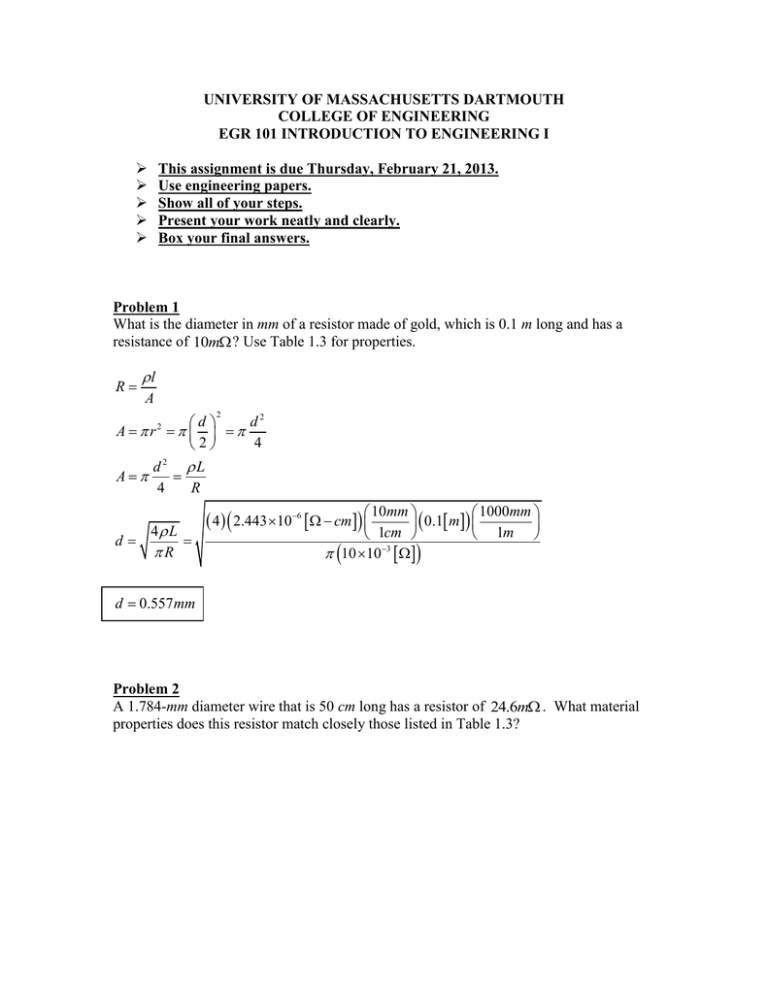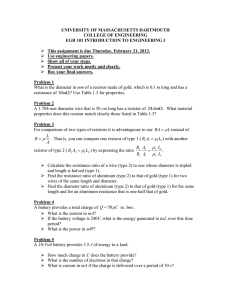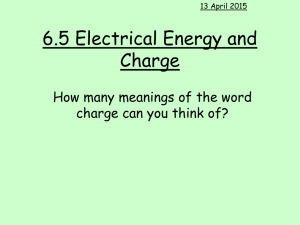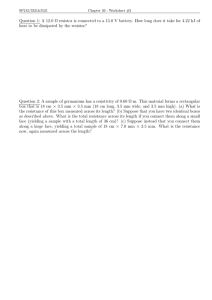Document 14968935
advertisement

UNIVERSITY OF MASSACHUSETTS DARTMOUTH COLLEGE OF ENGINEERING EGR 101 INTRODUCTION TO ENGINEERING I This assignment is due Thursday, February 21, 2013. Use engineering papers. Show all of your steps. Present your work neatly and clearly. Box your final answers. Problem 1 What is the diameter in mm of a resistor made of gold, which is 0.1 m long and has a resistance of 10m ? Use Table 1.3 for properties. R l A 2 d2 d A r2 4 2 2 d L A 4 R d 4 L R 4 2.443 106 cm 10mm 1000mm 0.1 m 1cm 1m 10 103 d 0.557mm Problem 2 A 1.784-mm diameter wire that is 50 cm long has a resistor of 24.6m . What material properties does this resistor match closely those listed in Table 1.3? R l A RA l d2 A 4 2 2 1cm 1.784 mm 10mm 3 24.6 10 4 50 cm 12.29 106 cm Checking Table 1.3, the material is iron. Problem 3 For comparison of two types of resistors it is advantageous to use RA L instead of L R . That is, you can compare one resistor of type 1 ( R1 A1 1L1 ) with another A R A L resistor of type 2 ( R2 A2 2 L2 ) by expressing the ratio 2 2 2 2 . R1 A1 1 L1 Calculate the resistance ratio of a wire (type 2) to one whose diameter is tripled and length is halved (type 1). R2 A2 2 L2 R1 A1 1 L1 R2 A1 2 L2 R1 A2 1 L1 d12 2 4 d1 A1 A2 d 22 d 2 4 d 2 3d1 A1 1 A2 9 L2 L 1 1 L1 2 2 L1 2 2 1 R2 A1 L2 1 1 1 R1 A2 L1 9 2 18 R2 1 R1 18 Find the resistance ratio of aluminum (type 2) to that of gold (type 1) for two wires of the same length and diameter. R2 A2 2 L2 R1 A1 1 L1 A1 A2 L1 L2 R2 2 R1 1 6 R2 2.825 10 cm 1.156 R1 2.443 106 cm R2 1.156 R1 Find the diameter ratio of aluminum (type 2) to that of gold (type 1) for the same length and for an aluminum resistance that is one-half that of gold. R2 A2 2 L2 R1 A1 1 L1 L1 L2 R1 2 R2 d2 A 4 A2 R1 2 L2 2 R2 2 2 2 A1 R2 1 L1 R2 1 1 d 22 4 2 2 d2 1 1 4 d2 2.825 10 6 2 2 2 d1 1 2.443 10 6 d2 1.52 d1 Problem 4 A battery provides a total charge of Q 50 C in 3ms . What is the current in mA? Q C 50 106 C I A 16.67 103 A 16.67mA 3 t s 3 10 s I 16.67mA If the battery voltage is 240V, what is the energy generated in mJ, over this time period? V E Q E QV 50 106 C 240V E 12 103 J 12mJ E 12mJ What is the power in mW? P VI P 240V 16.67 103 A 4W P 4W Problem 5 A 10-Volt battery provides 3.5 J of energy to a load. How much charge in C does the battery provide? E Q E 3.5 J Q 0.35C V 10V Q 0.35C V What is the number of electrons in that charge? e # electrons 0.35C e 2.1875 1018 electrons C 19 1.6 10 electron e 2.1875 1018 electrons What is current in mA if the charge is delivered over a period of 10 s? Q t 0.35C I 0.035 A 35 10 3 A 10 s I 35mA I







